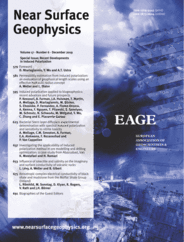-
oa Bacterial Stern layer diffusion: experimental determination with spectral induced polarization and sensitivity to nitrite toxicity
- Source: Near Surface Geophysics, Volume 17, Issue 6 - Recent Developments in Induced Polarization, Dec 2019, p. 623 - 635
-
- 27 Feb 2019
- 16 Jul 2019
- 07 Aug 2019
Abstract
Spectral induced polarization signatures have been used as proxies for microbial abundance in subsurface environments, by taking advantage of the charged properties of microbial cell membranes. The method's applicability, however, remains qualitative, and signal interpretation ambiguous. The adoption of spectral induced polarization as a robust geo‐microbiological tool for monitoring microbial dynamics in porous media requires the development of quantitative relationships between biogeochemical targets and spectral induced polarization parameters, such as biomass density and imaginary conductivity (σ″). Furthermore, deriving cell density information from electrical signals in porous media necessitates a detailed understanding of the nature of the cell membrane surface charge dynamics. We present results from a fully saturated sand‐filled column reactor experiment where Shewanella oneidensis growth during nitrate reduction to ammonium was monitored using spectral induced polarization. While our results further confirm the direct dependence of σ″ on changing cell density, Cole–Cole derived relaxation times also record the changing surface charging properties of the cells, ascribed to toxic stress due to nitrite accumulation. Concurrent estimates of cell size yield the first measurement‐derived estimation of the apparent surface ion diffusion coefficient for cells (Ds = 5.4 ±1.3 µm2 s−1), strengthening the link between spectral induced polarization and electrochemical cell polarization. Our analysis provides a theoretical framework on which to build σ″–cell density relations using bench‐scale experiments, leading to eventual robust non‐destructive monitoring of in situ microbial growth dynamics.



